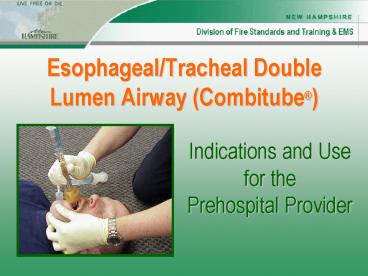EsophagealTracheal Double Lumen Airway Combitube - PowerPoint PPT Presentation
1 / 26
Title:
EsophagealTracheal Double Lumen Airway Combitube
Description:
Lubricate the tube with sterile, water soluble lubricant ... Stomach contents can be safely expelled via perforations in the side of the pharyngeal tube. ... – PowerPoint PPT presentation
Number of Views:1208
Avg rating:3.0/5.0
Title: EsophagealTracheal Double Lumen Airway Combitube
1
Esophageal/Tracheal Double Lumen Airway
(Combitube)
- Indications and Usefor thePrehospital Provider
2
Overview
- Introduction The combitube, what is it?
- Indications
- Contraindication
- Precautions
- Equipment
- Insertion procedures
3
History
- Developed in the early eighties.
- Intended to bridge the gap between a respiratory
arrest situation and the institution of a
definite airway when conventional endotracheal
intubation is not immediately possible. - The idea kept in mind was to allow for a quick
and easy method securing the patients airway and
adequately ventilating the lungs.
4
What is it?
- A double lumen airway device designed for
emergency ventilation of a patient in respiratory
arrest when visualization of the airway and
endotracheal intubation are not possible
5
Definition
- It is blind insertion device with dual lumens to
allow for effective ventilations to be provided
regardless of whether esophageal or tracheal
placement is accomplished.
Dual lumens
Distal Balloon
Pharyngeal Balloon
6
Definition
- The pharyngeal balloon fills the space between
the tongue and soft palate, eliminating the need
for a mask and the associated face mask seal
problems - The patient can be successfully ventilated
regardless if the tube is inserted into the
trachea or the esophagus
7
Indications
- Respiratory failure in an unconscious patient
without an intact gag reflex - Secondary method of airway management for
paramedics when orotracheal intubation is not
possible - Primary method of airway management for EMT-Bs
(where allowed by local protocols)
8
Contraindications
- The patient has in intact gag-reflex
- The patient is less than 5 feet tall or under 16
years old - The patient has known esophageal disease
- The patient has ingested a caustic substance
- Burns involving the airway
- The patient has an allergy or sensitivity to
latex (the pharyngeal balloon contains latex)
9
Precautions
- Take appropriate Body Substance Isolation (BSI)
precautions including facial protection, as
expulsion of stomach contents can occur through
the 2 tube if the initial placement is in the
esophagus - DO NOT force the tube. If it does not advance
easily, redirect it or withdraw and reinsert - Attach the fluid deflector elbow to the
esophageal tube to deflect stomach contents away
from rescuers
10
Equipment
- Full Body Substance Isolation (BSI). Face mask,
eye shield, protective eye-glasses, latex
examination gloves and hepa-mask if patient is
suspected of infectious disease
11
Equipment
- Esophageal Tracheal Airway (Combitube), 140ml
syringe, 20ml syringe, fluid deflector attachment
12
Equipment
- Suction device with FR suction catheter, BVM with
oxygen supply
13
Insertion Procedures
- Place the patient in a supine position
- Provide artificial ventilation via BVM and
hyperventilate the patient with 100 oxygen prior
to device insertion
14
Insertion Procedures
- Inflate both balloons prior to insertion to test
the integrity of the balloons - Should either balloon fail after insertion,
maintenance of the patients airway cannot be
assured
15
Insertion Procedures
- Position the patients neck in a neutral
position. - Lubricate the tube with sterile, water soluble
lubricant - Lift the tongue and lower jaw upward to open the
oropharynx
16
Insertion Procedures
- Insert the Combitube so that it curves in the
same direction as the natural curvature of the
pharynx - If resistance is met, withdraw tube and attempt
to reinsert
17
Insertion Procedures
- Advance tube until the patients teeth are
between the two black lines
18
Insertion Procedures
- Inflate the 1 blue pilot cuff with 100ml of air
from the large syringe
19
Insertion Procedures
- Inflate the 2 white pilot cuff with 15ml of air
from the small syringe
20
Insertion Procedures
- Begin ventilation through the longer blue tube
labeled 1. If auscultation of breath sounds is
good and gastric inflation is negative, continue.
21
Insertion Procedures
- If auscultation of breath sounds is absent and
gastric inflation is positive, then begin
ventilation through the shorter clear tube
labeled 2
22
Esophageal Placement
- If the Combitube is placed in the esophagus, the
distal balloon will occlude the esophagus. - Ventilations are provided through perforations in
the side of the pharyngeal tube. - Stomach contents can be safely expelled via the
hole in the end of the tube.
23
Tracheal Placement
- If placed in the trachea, it functions as an
endotracheal tube, with the distal balloon
preventing aspiration. - Ventilations are provided via the hole in the end
of the tube. - Stomach contents can be safely expelled via
perforations in the side of the pharyngeal tube.
24
Verify
- During ventilation observe end-tidal CO2 monitor
or pulseoximetry to confirm oxygenation
25
QUESTIONS?
26
References
- Frass M, Frenzer R, Rauscha F, et al.
"Ventilation with the Esophageal Tracheal
Combitube in Cardiopulmonary Resuscitation."
Critical Care Medicine 15609, 1987. - American Society of Anesthesiologists Task Force
on Management of the Difficult Airway. "Practice
Guidelines for Management of the Difficult
Airway." Anesthesiology 78597, 1993. - Gaitini LA, Vaida SJ, Somri M, Fradis M.
"Fiberoptic-guided Airway Exchange of the
Esophageal-tracheal Combitube in Spontaneously
Breathing versus Mechanically Ventilated
Patients." Anesth Analg. 1999 Jan88(1)193-6. - Gaitini LA, Vaida SJ, Mostafa S, Yanovski B,
Croitoru M, Capdevila MD, Sabo E, Ben-David B,
Benumof J. "The Combitube in Elective Surgery A
Report of 200 Cases." Anesthesiology. 2001 Jan
94(1)79-82.

